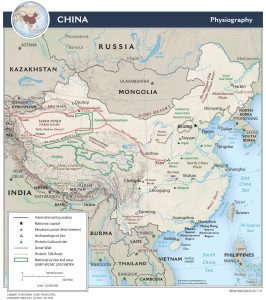26 Geography
The ancient Chinese thought of their state as the “middle kingdom” or “central kingdom”. This name, which probably dates back to the Zhou Dynasty (1040 BCE – 256 BCE) is partly geographical. Natural barriers surrounded this ancient culture: deserts to the west, the high Himalayan mountains to the south, and the ocean to the east. “Middle Kingdom” also refers to the status of ancient China as a trading destination: trade routes from India and the Middle East crossed the deserts of inner Mongolia, north of the Himalayan mountains to reach China. Trade then continued eastward toward Korea and the Japanese islands.
The “middle kingdom” or as some scholars say, “central kingdom” was also a psychological and political term. This name was a way of saying that their culture was central. Chinese viewed their culture as being higher, more advanced, and the center of civilization for a vast region.

The land designated as the central kingdom varied during Chinese history. In periods of peace and cooperation “China” expanded its territory. Sometimes, however, the political entity of the middle kingdom was divided by competing factions. From 1279 to 1368 China was ruled by Mongolians whose famous warrior, Kublai Kahn, had defeated the ruling Song dynasty.
